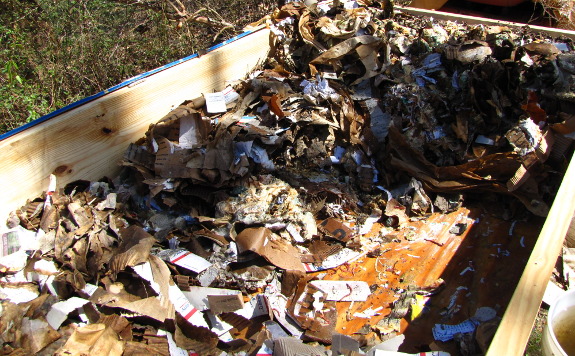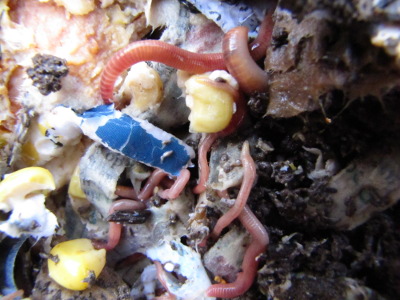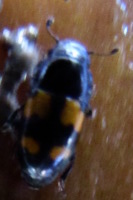
Worm bin, one month later

One month after starting
our worm
bin project,
three quarters of the bin floor was covered with food scraps. I
figured it was time to push the decomposing scraps and bedding toward
one end of the bin so that I would have room to put in the next batch
of food. This also gave me a great opportunity to see what was
and wasn't working in the main decomposition zone.
 The
good news is that there are worms everywhere. Our redworms
seem to be reproducing very quickly since every bit of the bedding is
colonized with a healthy population of worms. The easy to
decompose waste --- spinach
leaves, for example
--- had already been converted into worm castings, but a few areas
where great globs of mashed potatoes hadn't mixed into the bedding were
moldy and not appropriate for worm action yet. I'll have to
remember to layer the food waste a little less thickly and include more
bedding with similarly gloppy waste in the future.
The
good news is that there are worms everywhere. Our redworms
seem to be reproducing very quickly since every bit of the bedding is
colonized with a healthy population of worms. The easy to
decompose waste --- spinach
leaves, for example
--- had already been converted into worm castings, but a few areas
where great globs of mashed potatoes hadn't mixed into the bedding were
moldy and not appropriate for worm action yet. I'll have to
remember to layer the food waste a little less thickly and include more
bedding with similarly gloppy waste in the future.
 I
was also pleased to see that the
worm bin was already turning into a healthy ecosystem. When I got
started with worms, I assumed that worms did all of the decomposing in
the bin, but the truth is that you'll find insects of all sizes working
alongside your livestock. Many of the wild critters are good
news, starting the decomposition process so that worms can do their job
faster --- I suspect that this picnic beetle (probably attracted to a
high density of pickles) falls into that category. On the other
hand, the few house flies I saw in the bin are warning lights, telling
me that I need to top off the food with a bit more bedding.
I
was also pleased to see that the
worm bin was already turning into a healthy ecosystem. When I got
started with worms, I assumed that worms did all of the decomposing in
the bin, but the truth is that you'll find insects of all sizes working
alongside your livestock. Many of the wild critters are good
news, starting the decomposition process so that worms can do their job
faster --- I suspect that this picnic beetle (probably attracted to a
high density of pickles) falls into that category. On the other
hand, the few house flies I saw in the bin are warning lights, telling
me that I need to top off the food with a bit more bedding.
Total food waste
liberated from the landfill to date has been 699
pounds. We've put about a fifth of that in the bin so far, with
the amount increasing each week as our worm population grows.
Want more in-depth information? Browse through our books.
Or explore more posts by date or by subject.
About us: Anna Hess and Mark Hamilton spent over a decade living self-sufficiently in the mountains of Virginia before moving north to start over from scratch in the foothills of Ohio. They've experimented with permaculture, no-till gardening, trailersteading, home-based microbusinesses and much more, writing about their adventures in both blogs and books.
Want to be notified when new comments are posted on this page? Click on the RSS button after you add a comment to subscribe to the comment feed, or simply check the box beside "email replies to me" while writing your comment.
- Remove comment
 If you follow the link to "worm bin project" in this post, you'll see the long answer, but the short answer is that we're getting all of the cafeteria food waste from our closest school. They've only got 80 students, though, so imagine how much food you could get from an average-sized school!
If you follow the link to "worm bin project" in this post, you'll see the long answer, but the short answer is that we're getting all of the cafeteria food waste from our closest school. They've only got 80 students, though, so imagine how much food you could get from an average-sized school!
- Remove comment
